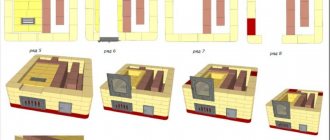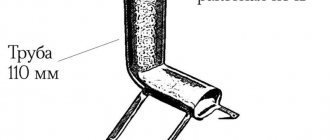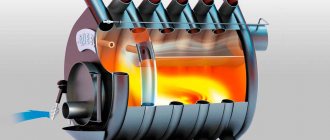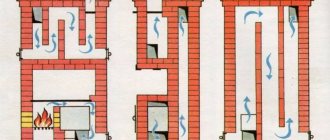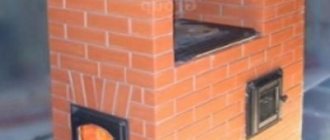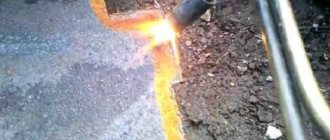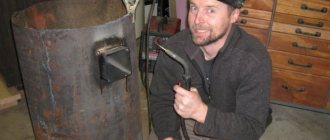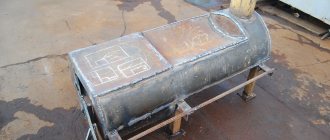The operating principle of all types of rocket designs is approximately the same:
- Solid fuel (firewood) is placed in the firebox.
- Ignition is in progress.
- When heated by flame and combustion, gases are produced.
- Their movement begins along the vertical section of the pipe.
- The supply is provided by a special channel through which “secondary air”, which is already heated, quickly moves.
- Heated gases rise to the base of the pipe.
The basic operating principle is similar to pyrolysis boilers. As a result, at the outlet of the furnace, the maximum possible temperature is reached in the upper part of the structure. It is used for heating, heating water, and cooking. For convenience, you can make a special platform for placing containers by attaching it to the top of the pipe.
A big and significant advantage for the user of a rocket stove is its efficiency - firewood, as well as other types of solid fuel, are consumed little, the efficiency is high (about 65%). In order to improve the quality of functioning, it is enough to throw sawdust, paper, branches or dry grass into the firebox.
Operating principle
This device is made on the basis of a heating rocket stove. The mechanism of its operation is as follows. There is a bunker, which is a fuel compartment in which solid fuel burns. Combustion products enter the horizontal section of the pipe, and then into the vertical section. At the initial stage of the furnace operation, intense heating of the chimney is observed. When a high temperature is reached, the device enters operating mode. This happens when the gases formed during the combustion of wood in a vertical pipe ignite and produce good heat.
Robinson's device is a somewhat simplified rocket stove. This is explained by the different purposes of the units. The first model does not require space heating, but only water heating and cooking. But the principle is the same. Firewood smolders in the bunker, which heats the chimney, where the gases then burn out. In this case, the chimney must be quite long so that no combustion products remain.
In order for the reactive furnace to operate efficiently, the following rules must be observed when installing the structure:
- The chimney must be at least twice as long as the horizontal or inclined section.
- The length of the fuel compartment must coincide with the horizontal section. Typically the firebox is installed at an angle of 45°, although there are designs with an angle of 90°. But they are less convenient in terms of fuel loading.
- The cross-section of the chimney should not be smaller than the fuel compartment itself.
Enjoying cooking outdoors
I tried frying bacon and eggs. You can even cook a whole pot of beans.
Thanks to the oven, you only need a couple of logs to fully cook a dish. And the wood will burn out completely, creating almost no smoke.
We increase the stability of the structure (hull)
It's time to improve the result of the work.
The oven turned out to be generally successful, but a little unstable. To improve this characteristic, I used a cable from a bicycle brake system, adding a hole in the housing.
We increase the stability of the furnace structure
Now you can attach the base to the fuel hopper.
The oven has thus become significantly more stable and has not undergone major changes in terms of transportation.
Device
Robinson factory camping stoves are made from a profile pipe with a cross-section of 150×100 mm. Homemade structures are made of the same size. In this case, the bunker is made of a profile pipe, and the chimney is made of a round pipe. In order for there to be normal draft, the chimney pipe must have a diameter no less than the cross-section of the firebox.
For this size of the fuel compartment, a chimney no longer than 90 cm is allowed. But such dimensions make the unit inconvenient for transportation, so it is better to limit it to a minimum of 60 cm.
A steel rod is used for the legs. They are threaded, making the supports easy to install and remove. However, after using the jet stove many times, it becomes quite sooty, so the process of screwing the legs is not very pleasant. However, other options are also common, where a steel sheet is used to make the stand or non-removable legs are installed. But this makes the structure larger and more inconvenient to transport.
Robinson factory stoves do not provide air supply to the combustion zone, and they also do not have an adjustable lid that changes air access. This point can be corrected in homemade ovens. A plate is welded inside the bunker for flammable substances, at the bottom of which there is a grate. Fuel is placed on a flat element. Air enters the combustion zone through the grate, and a damper can be installed at the top of the firebox, with which the air supply will be regulated. It is made somewhat smaller than the firebox and should not completely block the hole, otherwise air will stop flowing into the compartment and the fire will go out.
This design of a reactive furnace provides a number of advantages:
- a small amount of solid fuel allows you to bring water to a boil in a short time, heat up food or cook simple dishes;
- Robinson is not afraid of the wind, so the fire does not go out;
- the jet stove is easy to install;
- the device does not smoke or smoke;
- factory models are made of high-quality metal and coated with heat-resistant paint that can withstand high temperatures;
- fuel does not burn out too quickly;
- the device allows you to dry firewood;
- the design is stable and easy to use;
- the rocket stove heats up quite quickly;
- maximum surface temperature reaches 900 °C;
- Thick steel (3.5 mm) ensures the durability of the device.
The price of the factory model is approximately 5 thousand rubles. But you can save money by making such a unit yourself. This task is doable if you have certain skills.
Design Features
Buleryan stoves differ only in size and additional elements.
- The firebox is formed from bent pipes of round or rectangular cross-section, which serve as a convection jacket and body. The design resembles a horizontally mounted cylinder welded from bent pipe elbows.
- The door can be round or square. Its size is more important - the larger it is, the easier it is to maintain and load more firewood.
- In Buleryany there is no ash pit or grate. The air flow is regulated by a valve on the door; with its help, you can completely block the access of oxygen.
- The secondary chamber - the afterburning chamber - is separated from the firebox by a screen made of bent thick sheet of steel. It starts on the second or third bend of the firebox.
- An important feature of the stove is the presence of air injectors. These nozzles supply air into the afterburning chamber of pyrolysis gases from the first leg of the housing and increase the efficiency of the stove to 85-90%.
- For proper operation, additional fittings are needed - locking mechanisms, door seals, valves for air supply and exhaust.
- Increased heat removal and safety during operation are provided by heat shields made of sheet steel. They also give a presentable appearance.
DIY Robinson factory model
Making a rocket stove similar to the one produced in factories is not a difficult task. There are not so many structural elements in this model:
- Metal pipe with a diameter of 100 mm and a length of 600 mm.
- A fuel box of 300×150×100 mm is made from a 3 mm steel sheet. To do this, it is cut into plates: 2 300x150 mm, 2 300x100 mm and one 150x100 mm.
- The grate grate is made from scraps of reinforcement with a diameter of 7-8 mm and a length of 120 mm.
- A metal plate 200x150 mm, which will divide the bunker into a fuel compartment and an ash duct.
- Three 13 nuts for screwing the legs. They will be installed on the bottom of the hopper.
- From a pipe with a diameter of 100 mm, rings with a height of 25-30 mm (3 pieces) and one with a diameter of 110 mm are cut.
- Three studs of the same length or M8 bolts for the legs. You can use 3 pieces of rod with similar threads.
As for the dish stand, its configuration is not fundamentally important for the operation of the device. Therefore, this element can be done differently. In this case, it is important to follow the rule that the stand should not block the chimney opening, so as not to disrupt the draft.
In the model under consideration, 3 rings are cut in half and welded to a metal rod.
This design is more complicated than the previous one in that the cross-section of the box is rectangular, and the chimney is round. Therefore, it is important to correctly perform the operations of connecting two parts into one device. In general, the production technology is as follows:
- It all starts with making a plate with a grid that will divide the bunker into two parts. To do this, pieces of reinforcement are welded to the flat element in increments of 10 mm.
- The resulting part must be welded to the rear and side walls of the bunker. The distance from the bottom edge to the plate with the grid should be 30-35 mm. The part must be attached using a welding machine parallel to the bottom edge.
- Then you need to carefully weld the joints of the walls together.
- The bottom is attached to the resulting structure, and nuts are attached to it.
- The top plate is welded to the back and side walls.
- A cut at an angle of 30° is marked on the pipe. The unnecessary part is cut off.
- The end that has acquired the shape of an oval must be attached to the upper section of the hopper. In this case, the pipe is placed at the very bottom of the upper plate and equidistant from the side walls. This element is outlined with a marker, and a hole is cut according to the markings. To do this, you can use a welding machine or a metal cutting device.
- Then you need to attach a pipe to the resulting hole. A stand is installed on top of it, and the legs are screwed into the nuts. Now the rocket stove can be tested. After this, it is covered with heat-resistant paint.
Bubafonya - the most popular long-burning potbelly stove design
The practicality of the Bubafonya stove is proven by its popularity.
The fact that this is one of the most popular long-burning stoves is evidenced by the fact that it is used in almost all small greenhouse farms. The great advantage of this stove is its practicality and ease of use - it is practically omnivorous; dry firewood, sawdust, pellets and briquettes made from straw or sunflower can be burned in the firebox. This stove also shows one of the highest results in terms of fuel combustion duration.
The basic concept of this heating device is that the fuel combustion process combines the process of burning conventional fuel with a controlled supply of oxygen and the process of pyrolysis. The design of the furnace is a metal body with an open top. For the body, a 200 liter thick-walled metal barrel is most often used. It contains a central rod, made of a thick-walled pipe, with a rigidly welded metal disk slightly smaller than the internal diameter of the barrel. The height of the pipe is 10-15 cm higher than the barrel. Ribs are welded on the bottom side of the disk so that there is a small space between the disk and the bottom of the barrel - this is necessary for oxygen access to the firebox. The third element of the design is a structure similar to a guide with a disk. The difference is that the diameter of the pipe is larger than the guide, and the disk itself has holes throughout its entire area. It is put on the internal guide and gradually moves down as the fuel burns. The lid is made of thick metal so that the hole allows the press to lower evenly as the fuel burns. The chimney is sealed in the upper part of the body at a distance of 5-7 cm from the top.
How bubafoni works
Before use, the central guide is inserted into the housing. The entire volume of the body is filled with fuel - firewood, briquettes, flights. The firewood is stacked vertically very tightly. The height of the bookmark should be 5-7 cm below the top cut of the barrel. After this, the upper press is installed on the guide and the cover is put on. Ignition is carried out from above. After the fuel combustion process begins, a process of gradual temperature rise occurs - oxygen enters through the pipes into the combustion chamber. When the temperature rises to 300 degrees, the process of gas formation begins. The gases rise upward and the flame moves into the space between the lid and the upper press. Thus, the process of combustion of gases begins. To regulate the burning speed, an adjustable damper is installed on the pipe of the upper press. When using such a stove, one load of firewood is enough for 48-72 hours of burning.
Manufacturing a modernized Robinson furnace
The model described in the previous section can be improved with the help of a door that is installed on the fuel hopper. But if you make the sash on hinges, it will simply tilt upward, which will not allow you to adjust the draft. Such a part can only be in the “closed” or “open” position. It will be much more effective to use a damper that moves vertically or horizontally. To install it, you need to weld small corners measuring 10x10 mm or 15x15 mm onto the hopper.
In addition, the following options for modernizing the furnace are noted:
- the fuel hopper can be made of thicker steel, for example 5 mm;
- replace the round chimney pipe with a square one;
- for the stand, use a different design: as an option, take corners, balls or other elements that are at hand;
- change the stand for the camping rocket stove, for which a metal plate and a piece of reinforcement can be used to make a leg.
To make a modernized stove, you will need the following materials:
- Square pipe with a cross-section of 160×160 mm and a length of 400 mm. The firebox will be made from it.
- Square pipe with a cross-section of 120×120 mm and a length of 600 mm. It is needed to make a chimney.
- A five-millimeter sheet of steel and a piece of reinforcement with a diameter of 7-8 mm. The element separating the fuel compartment and the ash duct will be made from them. The size of the part should be 300×155 mm.
- Steel sheet 350×180 mm. This material is necessary for the manufacture of a stove stand.
- Steel sheet measuring 160×100 mm.
The production technology of this model of camp stove is not fundamentally different from the creation of similar structures:
- A metal plate with a grate must be welded to the walls of the bunker.
- Then the back of the container is attached, and the chimney is attached on top.
- When the entire structure is ready, a metal stand is welded to it from below, and an additional support is made from a piece of reinforcement. You can also use part of the vertical pipe that remains after cutting.
- Pieces of corners are welded on top of the vertical pipe, which will form a stand for dishes. Its height should be 40-50 mm.
- The hole in the fuel tank must be closed with a hinged door or a flap inserted into the corners.
- The finished product can be tested. If everything went well, the welds are cleaned and the reaction furnace is coated with heat-resistant paint. This will not only give the product a more attractive appearance, but will also protect the metal from corrosion.
Efficient heat extraction
The gases entering the chimney duct are still at a high temperature. It is not advisable to simply throw them outside; everyone will understand that the efficiency of such an installation will be too low. Taking advantage of the fact that the rocket stove literally pushes combustion products out, craftsmen have come up with 2 ways to extract heat:
- passing gases through channels arranged under the stove bench;
- installing a water circuit on the stove.
A rocket stove with a water circuit is made without a hood; the force of the upward flow of combustion products is used in a multi-pass heat exchanger made of metal. It is not recommended to introduce a coil of water into the gas flow; it will not last long due to the too high temperature. It would be more correct to make a water jacket with metal fins inside the flue, as shown in the diagram:
Another way is to lay horizontal chimney ducts out of brick directly along the floor surface and place a luxurious heated adobe bench on top, connecting a rocket-type stove to it. What is important here is the correct selection of the length of the channels so that the excess pressure is enough to overcome them, otherwise you will still have to take care of organizing natural draft.
Application area
The rocket furnace is used in mobile and stationary versions.
In addition to cooking on the go, you can use it to:
- heating of residential premises;
- fruit drying;
- heating of greenhouses;
- ensuring positive temperatures in workshops, garages, utility rooms and warehouses.
The unit is especially popular among fishermen and hunters, car rally enthusiasts and survivalists. There is a special version, the purpose of which is indicated by the name itself - “Robinson”.
Advantages and disadvantages
Homemade long-burning rocket stoves have many admirers, and for the following reasons:
- simplicity and low cost of installation: to build such a thermal device, you do not need to incur large expenses for the purchase of expensive materials, fixtures and fittings. Minimal experience in the furnace business is also required;
- self-regulation and undemandingness to the natural draft of the chimney;
- The efficiency of the rocket furnace is a variable value and largely depends on the design, the main thing is to extract as much thermal energy as possible from the flue gases;
- fuel can be added on the fly.
Despite the attractiveness and simplicity of the unit, heating with a rocket stove has its negative aspects. It is a mistake to think that you can shove firewood of any quality into the firebox. Wet wood will not provide the required temperature in the chamber, and the pyrolysis process will not proceed. In the worst case scenario, smoke from the furnace can pour into the room. Also, the “rocket” requires constant supervision, especially in terms of fire safety.
Self-made rocket stoves are unsuitable for a bathhouse, since they give off relatively little heat in the infrared range, which is very important for a steam room. The surfaces of the stove that emit heat have too small an area and it will not be possible to heat the bathhouse properly
How to do with a bed
A more complex option is a stove with a stove bench, which is placed indoors. It is universal: suitable for heating a room, drying clothes, cooking.
- The principle of masonry is similar to that described above, but the design is more complex. First lay out the base, then place the bricks in the second row, forming channels for heating the bed. In the second row, mark the mortgages for the doors.
- The third row completely follows the contours of the second. In the fourth, close the fuel channels, form a firebox and a vertical channel for the smoke to escape.
- Place a bench in the fifth and sixth rows, and continue forming a smoke channel in the fuel zone. Work continues according to the standard pattern for the next few rows.
- Having finished laying out the fuel, you need to attach the doors with hinges.
- In the twelfth row, start laying the chimney. Insert the pipe into place and remove it through the hole in the roof.
- The next row forms the hob in the fuel zone. Place an asbestos gasket on it, which is covered with a steel sheet.
- The fourteenth and fifteenth rows complete the formation of the chimney; lay a low wall between the stove bench and the fuel zone.
- The folded stove needs to be dried. Place a little fuel into the combustion hole and continue heating until the wet spots disappear from the brick. Typically the oven takes at least 3 days to dry; speeding up the process can lead to cracking.
The rocket stove is a reliable and inexpensive design that will last for several years and will not require repairs. You can use coal, firewood, ready-made briquettes and any flammable waste as fuel.
Preparing the foundation
- in the place where you plan to place the stove, make a hole 0.5 meters deep, the length and width can be increased to 0.7 meters;
- approximately 0.3 meters high, fill the prepared hole with very fine crushed stone and carry out thorough compaction;
- prepare a cement composition based on cement-sand in a ratio of 1 to 4, dilute the mixture with water and pour it onto the crushed stone;
- within 24 hours the base will dry and become hard - place several sheets of roofing material on top for reliable protection from moisture;
- prepare a concrete composition of cement, sand, fine gravel and water in a ratio of 1:2:4 and pour it onto the roofing material;
- carefully level the base using a building level;
- after drying, make a brick platform approximately 0.7 meters in width and height;
- also arrange a protective brick screen up to 1.2 meters high - in the future the stove will be located in close proximity to it, approximately at a distance of 0.2 meters.
Expert advice
You can insulate the walls not only with brick, but also with some other materials: asbestos-cement slabs, mineralite (fiber cement slabs) and cover them on top with decorative metal sheets, stainless steel, and special ceramic tiles.
You can install ready-made purchased doors as doors. By placing a glass door on the firebox, you will get a beautiful visual effect of a live fire, like in a fireplace.
It is advisable to protect the iron body with a decorative grille to protect visitors from burns. Sometimes stones are placed behind these grates and used as an open heater.
General principles
The portable portable stove "Robinson" was made on the basis of a heating rocket stove. The same principle is applied: firewood burns in the bunker-fuel compartment, the fire, due to the air flow, enters the combustion zone - a horizontal section of the pipe and partially rises up the smoke tube. First, while the stove is not heated up, all the energy is spent on heating the chimney. Then, when it warms up, the gases from high temperatures ignite again, and secondary combustion of the gases occurs. Modern gas-generating pyrolysis boilers are designed according to the same principle.
How does a rocket stove work?
In the Robinson oven, everything is a little simpler: we don’t need to heat the room. Its main task is to heat water and cook food. But the principles remain the same: the fire must heat the chimney, and its length must be enough to burn off the gases. Therefore, for normal performance, adhere to the following proportions:
- The length of the chimney must be at least 2 times the length of the horizontal (sloping) section.
- The height of the fuel compartment is approximately equal to the length of the horizontal section. Therefore, in the Robinson stove, the firebox is made at an angle of 45°, although the fuel compartment can be located at an angle of 90°, but it is not very convenient to place fuel this way.
- The cross-section of the chimney should not be smaller than the size of the firebox.
Construction
To enlarge, click The main distinguishing feature of the Pompeii oven is the presence of a hemispherical vault.
The advantage of this arch is the uniform distribution of the temperature of the burning fire over the entire surface of the Neapolitan stove. To build a Neapolitan stove, you must follow a certain algorithm of actions; it consists of four main steps.
Let's look at the construction diagram of a Pompeian oven:
- Like all structures, the construction of the Pompeii furnace must begin from its base (foundation).
- The stand rises to a height convenient for you and is placed on the already made base of the Pompeian stove. The stand is usually made of brick, but can be made of metal materials. The Pompeian stove stand can be used to store firewood (if you use this type of fuel resource).
- When you have made a stand, a table is installed on it. The material from which the table is made is concrete.
The thermal insulation layer contains a concrete mixture. Also contains perlite. Perlite is a rock that is of volcanic origin, comes in the form of sand, and is used in the construction of various structures.
- The wood-burning Pompeian oven itself for preparing various types of baked goods is made of bricks. The brick material must withstand high temperatures for the Neapolitan oven to function properly.
- Thermal insulation is necessary, since the oven quickly reaches its temperature in a short period of time, and the cooling of the Neapolitan oven takes a rather long period, which allows you to cook pizza and other baked goods at different temperatures.
This “baby” will allow you to quickly warm water in extreme conditions
A stand for a container with water can easily be made from the bottom or lid of a jar by cutting out the middle of it, then making cuts on the inside of the resulting circle, and bending them down to form legs. This stand fits perfectly on the edges of the jar. The stand can also be made from steel wire by carefully bending several pieces and fastening them together.
Robinson type camping stoves
Today, various compact rocket-type camping stoves are on sale, with different names, including “Robinson”. However, an experienced craftsman, having looked at the structure of such a device, will immediately understand its design and will be able to draw up a drawing according to which it will not be difficult to manufacture it.
It is clear that the manufacture of such stoves will be available only to those home craftsmen who have the skills of plumbing and welding and have the necessary equipment and tools at their disposal.
Every good home owner should be familiar with welding technology!
In the everyday life of a private home, there are very often situations where it is very difficult to do without welding work. It is not enough to have a device - you need to have certain skills. We hope that a special article on our portal dedicated to the basics of working with electric welding
, will be a good tutorial for beginners.
You need to know that all camp stoves operating according to the principle described above have common parameters that must be taken into account when drawing up a drawing diagram, otherwise malfunctions may occur in the functioning of the structure. These characteristic features include the following:
- The vertical pipe must be at least twice as high as the length of the combustion hopper.
- The height of the fuel hopper, installed vertically, should be approximately equal to the length of the horizontal connecting section of the stove and the width of the combustion opening.
- The best location for the combustion chamber would be to install it at an angle of 45 degrees, since the plenum clearance is optimally located in it, and it is also convenient to place fuel in it.
- It is recommended that the cross-section of the fuel bunker inlet be approximately equal to that of the vertical pipe.
The first version of a camp stove
This model of camping stove is simple in design and manufacture and very compact in size. It does not require a large amount of materials, and it can be made in just a few hours.
Advantages and disadvantages
The advantages of a rocket-type furnace include:
- High thermal output, which in some cases reaches 18 kW;
- High efficiency;
- Ultra-efficient operation, which is characterized by complete burnout of firewood, coals and soot loaded inside;
- Even waste from the woodworking industry (chips, leaves, twigs, branches, leaves, regardless of the degree of humidity) is suitable for combustion;
- Economical combustion and low wood consumption;
- High temperature conditions at the outlet (heating a large container of water is carried out in a few minutes).
Along with the advantages, stoves of this type also have disadvantages:
- Installing a water heating coil reduces the thermal efficiency of the furnace;
- The continuous combustion cycle makes it impossible to install a rocket stove in garages and bathhouses;
- The small size of the firebox does not allow loading a large amount of fuel at once; to ensure long-term combustion, firewood is constantly added.
Children's drawings for Victory Day
What could be simpler than drawing for children. Such creativity develops worldview and thinking; with the help of drawings you can convey the experiences and attitudes of a child. If the child does not want to or does not yet know how to draw well, then we have prepared templates. Fold the sheet in half to make a postcard, and place a drawing on the front side.
We color with paints, felt-tip pens, pencils - it doesn’t matter at all. The main thing is to get an interesting result
The pencil looks very, very good for congratulations. Older children, in a word, high school students, use paints.
Let me tell you, the work that schoolchildren do is amazing. Sometimes you are amazed at the imagination of the new generation.
Not everyone knows how to draw, so we offer coloring books.
On the Internet, you can find anything you want. So now there is no problem of coming up with something to make, but now another problem arises of what to choose and do. Since there are a lot of ideas, my eyes run wild! The boys will like the following drawing.
We have no right to upset the girls and found an interesting drawing for them.
We haven’t yet thought about how to congratulate the veterans of the Great Patriotic War. Maybe then the following ideas will help you.
What is
A sauna without a stove is not a sauna! This is not just a heating device, it is the soul of the bathhouse. The speed of heating the house and heater, the microclimate in the steam room and your mood depend on the correctly selected stove.
We have all seen – some with our own eyes, some in films – the famous “potbelly stove”. A stove made from a pipe is very similar, but the version for a bathhouse differs in design - such a unit should have a heater and, possibly, a tank for heating water. All other elements are the same as other stoves: body, ash pan, firebox with grates, pipe.
Tools and materials
The main difference between rocket-type stoves and other solid fuel devices is the horizontal channel through which gases formed during combustion move more slowly. As they move, they actively give off heat, allowing you to heat a room or cook food using less fuel.
There are many options for manufacturing such stoves, but the most reliable, simple and aesthetically pleasing is the design made of refractory bricks. It can be used in the country house, in the garage and even outdoors by installing a canopy on top. There are options with a stove bench - such stoves are usually installed in construction temporary sheds or lodges.
To assemble a rocket-type stove yourself, you will need:
- simple red stove brick (the quantity depends on the size of the structure);
- fireclay bricks for laying out the firebox and bunker;
- sand and clay for binding solution;
- chimney pipe;
- doors and hinges;
- grates;
- blower;
- intermediate cap;
- construction mixer;
- container for solution;
- metal grate;
- trowel;
- grinder equipped with a diamond blade;
- pick;
- mallet;
- shovel;
- building level;
- tape measure and marker.
For a small but fully functional rocket stove you will need 21 bricks. This device is suitable for heating a room and heating food. If you intend to use coal for kindling, it is better to take a fireproof material that is not subject to cracking. For a stove with a stove bench, you need more building material; it is advisable to purchase it with a reserve.
Drawings of a jet stove from a gas cylinder and other types
Long-burning stoves are divided into stationary and mobile. Mobile stoves are used on hikes, picnics, and outdoors for heating and cooking food. Stationary ones are used for heating a house, outbuildings, greenhouses, and garages. There are 4 types of structures.
Types of reactive furnaces:
- Homemade camp stove made of metal pipes, buckets, cans;
- Jet design from a gas cylinder;
- Brick oven with metal container;
- Stove with a stove bench.
Drawings of a jet furnace from a gas cylinder can be downloaded on the Internet or made independently by hand.
The portable structure is equipped with pipe sections. The only difference concerns the installed partition for the ash pan. For the lower part, a grate can be used.
A device made from a gas cylinder is more difficult to build, but significantly increases efficiency. To install the structure, a barrel or gas cylinder is required. Firewood in the firebox burns due to the influx of oxygen by loading it through a special window.
The gases burn out in the pipe, which is located inside the structure, due to the supply of secondary air. The effect is enhanced by insulating the inner chamber. Hot air is placed in the hood, and then into the outer chamber. Combustion products are removed through the chimney.
The combined model made of brick and metal is a stationary structure. Due to its high heat capacity, a wood stove accumulates and releases heat over several hours. That is why residential premises are heated with this design.
The rocket unit with a bench is an improved device that can retain heat longer. Since some of the heat escapes through the chimney, we increased its length. Due to the rapid excision of hot gases and a larger smoke outlet, this problem was solved.
This creates massive stoves with a bench that look like a sofa or bed. These are stationary devices made of brick or stone. Thanks to its unique design, the stove is able to retain heat all night.
